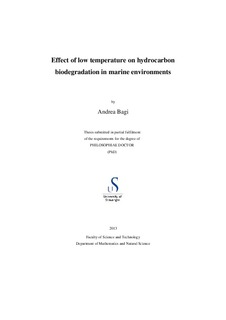| dc.description.abstract | Understanding the fate of oil discharges in cold marine environments has become a key issue as oil and gas industry is expandig exploration activities into frontier regions such as the Arctic Ocean. The aim of this research project was to assess a currently applied modelling approach for predicting crude oil biodegradation rate in the sea and evaluate its limitations. Furthermore, a relatively new static respirometry method was adapted for studying hydrocarbon (HC) biodegradation in seawater and to examine the effect of geographical origin of seawater on inherent biodegradation rate and temperature response.
The Oil Spill Contingency and Response (OSCAR) model, the industry standard in Norway to evaluate possible effects of accidental oil releases, takes biodegradation into account based on experimentally determined rate coefficient values. These values are adjusted to local ambient conditions by temperature compensation. Based on literature data and experimental observations, the compensation method implemented in the OSCAR model has been found to be debatable. Literature data and experimental results did not corroborate the rule of thumb approach used in the OSCAR model. The 32 different temperature compensation factors (Q10 values) calculated from published HC biodegradation rates ranged from 1.1 to 16.2 with an average of 2.8. The Q10 values for crude oil biodegradation obtained during laboratory tests were 2.6 and 9.9 at 5 and 0.5 °C, respectively. Crude oil type, incubation temperature range and other experimental factors were identified as important factors causing the high variation observed among Q10 values. Results showed that substrate limitation (reduced bioavailability) occurs at low temperature due to the effect of temperature on physico-chemical properties of oil. This temperature dependence of bioavailability implies that properties of crude oil influence the Q10 value. Hence, applying the same Q10 value for different oil types is not suitable. Besides bioavailability, initial number of bacteria participating in biodegradation is potentially affected by temperature, representing the second major cause of variation in observed Q10 values.
The OxiTop®-C system was found to be useful a tool for measuring HC biodegradation and for assessing the effect of different experimental and
iii
environmental factors on biodegradation kinetics. Seawater sample pre-treatments (e.g. filtration and aging) and dilution of seawater has been tested to understand their influence on kinetic parameters. Dilution of the seawater affected all parameters: lag time, maximum oxygen consumption rate and pseudo first order degradation rate. Filtration and aging of seawater samples did not influence pseudo first order rate coefficient, the parameter most often reported for HC and crude oil biodegradation, while results were inconclusive in terms of lag time and maximum oxygen consumption rate. The OxiTop®-C system is suggested to be a suitable tool for kinetic model development and validation, especially due to high resolution of measurement data.
Using naphthalene as a model compound, biodegradation rate, temperature response and bacterial community composition of seawaters from two geographically and climatically different areas (the North Sea and the Arctic Ocean) were studied and compared. Three times higher pseudo first order degradation rate coefficients were measured for naphthalene in arctic seawater samples compared to temperate, at all incubation temperatures. Calculated at in situ temperatures, rate coefficients of the two seawater types were similar (0.048 d-1 for temperate and 0.068 d-1 for arctic). Moreover, temperature responses were also found to be comparable with Q10 ratios of 3.3 and 3.5 for temperate and arctic seawater, respectively. Temperate and arctic untreated bacterial communities were different at genus level, as revealed by pyrosequencing, and dominating genera during naphthalene biodegradation was also distinct in the two seawater types.
Inherent biodegradation capacity in arctic seawater was shown to be comparable to temperate, implying that biodegradation capacity can be similar in cold compared to warm environments. Overall, approaches like a coupled physical-metabolic model for predicting HC biodegradation rates based on exponential growth of bacteria could represent better alternative compared to temperature compensation when estimating biodegradation rates in the sea. | no_NO |
